 "Réflexions sur une esthétique programmée" opened on Friday at bitforms. The exhibition is a retrospective of Manfred Mohr's work, on the pioneer of digital art, and borrow the title from the 1971 solo exhibition at the Musée d'Art Moderne de la Ville de Paris “Computer Graphics - Une Esthétique Programmée”, where the artist presented works entirely calculated and drawn by a digital (rather than analog) computer. Mohr (also a jazz musician) was highly influenced by the early 1960’s theoretical writings of the German philosopher Max Bense in the notion of defining of a programmed aesthetic, parallel to the the artist's design of electronic sound. Mohr's work was generated by FORTRAN programs (written by the artist himself) and printed in ink on paper by a plotter.
"Réflexions sur une esthétique programmée" opened on Friday at bitforms. The exhibition is a retrospective of Manfred Mohr's work, on the pioneer of digital art, and borrow the title from the 1971 solo exhibition at the Musée d'Art Moderne de la Ville de Paris “Computer Graphics - Une Esthétique Programmée”, where the artist presented works entirely calculated and drawn by a digital (rather than analog) computer. Mohr (also a jazz musician) was highly influenced by the early 1960’s theoretical writings of the German philosopher Max Bense in the notion of defining of a programmed aesthetic, parallel to the the artist's design of electronic sound. Mohr's work was generated by FORTRAN programs (written by the artist himself) and printed in ink on paper by a plotter.The exhibition well presents Mohr's transition in media throughout the past four decades: from sketches and black and white prints to video. Mohr's rigorous approach and philosophical reasoning are remarkable, especially in the context of contemporary digital art where the ease of the medium often leads to simplistic and superficial artwork.





